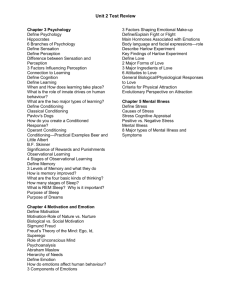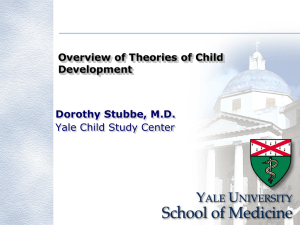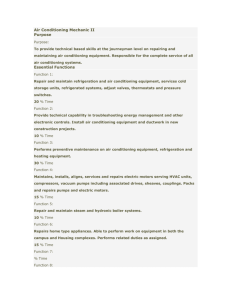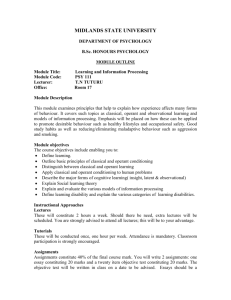Functionalist Provides Launching Pad (1977)
advertisement
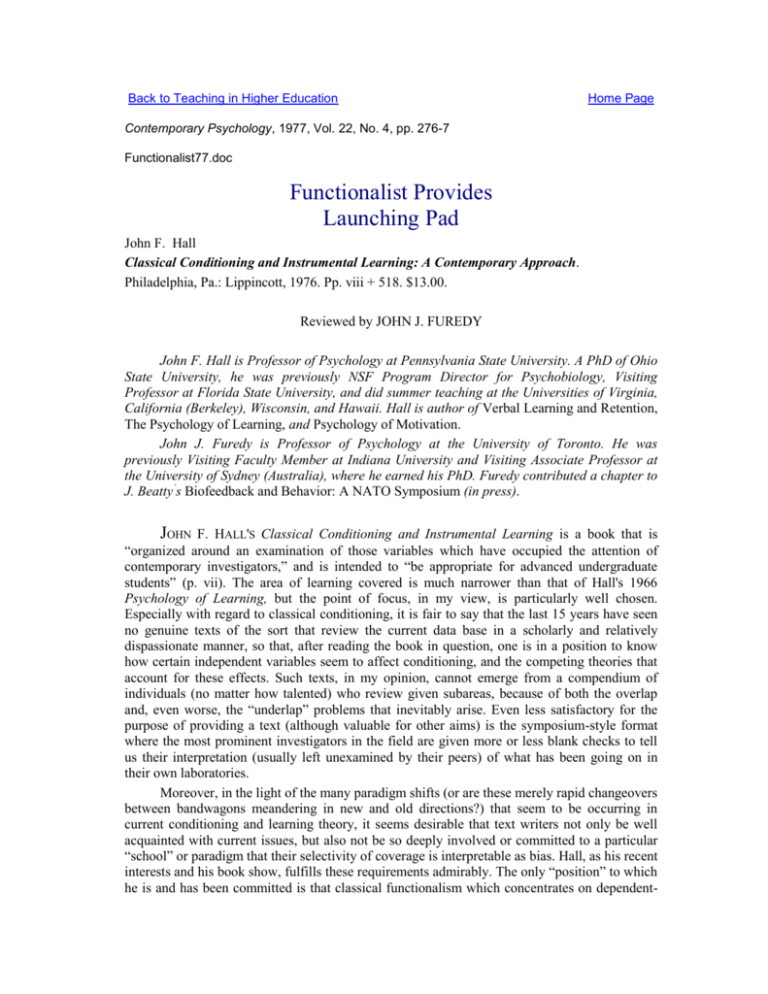
Back to Teaching in Higher Education Home Page Contemporary Psychology, 1977, Vol. 22, No. 4, pp. 276-7 Functionalist77.doc Functionalist Provides Launching Pad John F. Hall Classical Conditioning and Instrumental Learning: A Contemporary Approach. Philadelphia, Pa.: Lippincott, 1976. Pp. viii + 518. $13.00. Reviewed by JOHN J. FUREDY John F. Hall is Professor of Psychology at Pennsylvania State University. A PhD of Ohio State University, he was previously NSF Program Director for Psychobiology, Visiting Professor at Florida State University, and did summer teaching at the Universities of Virginia, California (Berkeley), Wisconsin, and Hawaii. Hall is author of Verbal Learning and Retention, The Psychology of Learning, and Psychology of Motivation. John J. Furedy is Professor of Psychology at the University of Toronto. He was previously Visiting Faculty Member at Indiana University and Visiting Associate Professor at the University of Sydney (Australia), where he earned his PhD. Furedy contributed a chapter to J. Beatty’s Biofeedback and Behavior: A NATO Symposium (in press). JOHN F. HALL'S Classical Conditioning and Instrumental Learning is a book that is “organized around an examination of those variables which have occupied the attention of contemporary investigators,” and is intended to “be appropriate for advanced undergraduate students” (p. vii). The area of learning covered is much narrower than that of Hall's 1966 Psychology of Learning, but the point of focus, in my view, is particularly well chosen. Especially with regard to classical conditioning, it is fair to say that the last 15 years have seen no genuine texts of the sort that review the current data base in a scholarly and relatively dispassionate manner, so that, after reading the book in question, one is in a position to know how certain independent variables seem to affect conditioning, and the competing theories that account for these effects. Such texts, in my opinion, cannot emerge from a compendium of individuals (no matter how talented) who review given subareas, because of both the overlap and, even worse, the “underlap” problems that inevitably arise. Even less satisfactory for the purpose of providing a text (although valuable for other aims) is the symposium-style format where the most prominent investigators in the field are given more or less blank checks to tell us their interpretation (usually left unexamined by their peers) of what has been going on in their own laboratories. Moreover, in the light of the many paradigm shifts (or are these merely rapid changeovers between bandwagons meandering in new and old directions?) that seem to be occurring in current conditioning and learning theory, it seems desirable that text writers not only be well acquainted with current issues, but also not be so deeply involved or committed to a particular “school” or paradigm that their selectivity of coverage is interpretable as bias. Hall, as his recent interests and his book show, fulfills these requirements admirably. The only “position” to which he is and has been committed is that classical functionalism which concentrates on dependent- independent variable relationships, and is relatively neutral concerning the processes that may intervene. This neutral approach, together with a lucid writing style, has yielded a scholarly, if somewhat unexciting, book about the contemporary data base and theorizing in the conditioning and learning area. In addition, the book's didactic qualities are enhanced by Hall's having apparently followed the advice of the CP reviewer of his 1966 book—to provide summaries at the end of each chapter. As a consequence of these qualities, perusal of this book is of great potential use not only for Hall's specific target population, "advanced undergraduates," but also for investigators who are many years past their PhD, but who, for one reason or another, have forgotten what they once knew about classical and instrumental conditioning, and who, in any case, no longer have any idea of what has been going on in the last 15 years in the area. Since specialization has increasingly isolated even people working within the area covered by Hall, the class of investigators to benefit from reading parts of Hall's book includes all active workers in the many subareas which make up the field of conditioning and learning. ON the other hand, the functionalist approach has its negative consequences, and these are exhibited in the book. Little or no attempt is made to state why “contemporary” investigators have picked certain problems and not others to concentrate on, as if these choices were quite arbitrary. A related shortcoming, again associated with a functionalist rather than a more in-depth approach, is the inclination to shelve difficult and potentially fascinating problems rather than to suggest at least partial solutions to them. To give just two examples, it is noted that despite “the obvious advantages of using dogs as experimental subjects” (p. 49) for classical salivary conditioning, American investigators, in contrast to those in Russia, have not used them. This comment even has a footnote, that, one would expect, would contribute suggestions toward an increased understanding of reasons for this difference, perhaps in terms of the different standards of statistical-methodological rigor which characterize the work of the two countries. However, the footnote merely gives figures to back up the claim for the differential Russo-American dog-usage rate. In the second example, contained in a footnote on page 78, the interesting problem of determining whether CS intensity affects learning or merely performance is brought up as a contemporary issue, but the problem is shelved by the rather puzzling assertion that “We do not believe that at the present time it is possible to provide an answer to this question.” This conclusion would be analytically satisfying if it were followed by an indication of what experiments needed to be done to resolve the problem, or even by an argument to indicate that the problem was, by its nature, not open to empirical resolution. Instead, Hall merely says at present “the conclusions drawn by different investigators vary.” Here the author clearly opts simply to repeat what the current experts are saying, without any attempt to analyze what is being said. Especially for students, functionalism carried to this level of descriptive-ness is, in my view, a bad didactic device. Another sign that description rather than analysis is the book’s apparent main aim is the way in which the chapter headings are organized and formulated. In general, I could see no organizational structure behind the 14 chapters in the sense that the treatment and number of chapters devoted to the two forms were dissimilar for no apparent reason. Why, for example, is there no discussion of “basic considerations” for instrumental learning as there is for classical conditioning in chapter 4? This apparent lack of willingness to analyze issues makes one feature of the style— use of the "we" in putting forward assertions that are only those of the author— particularly irritating. It is one thing for an author to endow a position with the plural pronoun after he has produced detailed arguments for it so that, in a sense, he can claim that both he and the reader now have no alternative than to accept the correctness of the position. It is another thing to make statements like “we believe that the bulk of the evidence . . . lends support to the position that . . .” (p. 56), when no such analytic arguments have been offered. Moreover, despite the descriptive approach taken by the book, it is not free from outright errors. For example, in describing GSR conditioning procedures and the problem that the CS elicits a response before conditioning (i.e., the CS is not “neutral”), Hall writes that “a sufficient number of trials in which the CS is presented alone must be provided at the beginning of the experiment in order for this response to habituate” (p. 49). In fact, this practice of prehabituating the CS is not regarded by most GSR conditioners as a necessary procedure for demonstrating GSR conditioning. More importantly, it is also not a sufficient procedure (contrary to the sense implied by Hall's statement), as Hall himself indicates a little later when, in talking about cardiac conditioning, he notes the methodological problem that despite prior habituation of responding to CS-alone trials, the “first presentation of the paired stimuli may reinstate” (p. 53) the response. Such errors, however, are very rare in a book that, in general, provides an excellent and badly needed source of the current data base underlying classical conditioning and instrumental learning. The various "revolutions" that have occurred, such as the recent demonstrations of apparent classical conditioning phenomena with very long CS-US intervals, are noted by Hal. Indeed, the most spectacular development—autonomic operant conditioning—receives a chapter of its own, and here, contrary to the impression that I have given previously, Hall's treatment is quite analytic and critical. For example, he includes the problem of replication that apparently exists with the animal work and that, at least in the most prestigious journals, has still not been fully expounded by the investigators themselves. This book, then, is the work of a scholar. Not all of us would agree with his emphases, and some might have wished for a book in which the arguments are followed through in a more sustained manner rather than being merely described. But there is no question that the author's goal, as stated at the outset, has been clearly met. Not only advanced undergraduate students but anyone wishing to learn about topics in conditioning and learning will benefit greatly from reading and consulting this book.



